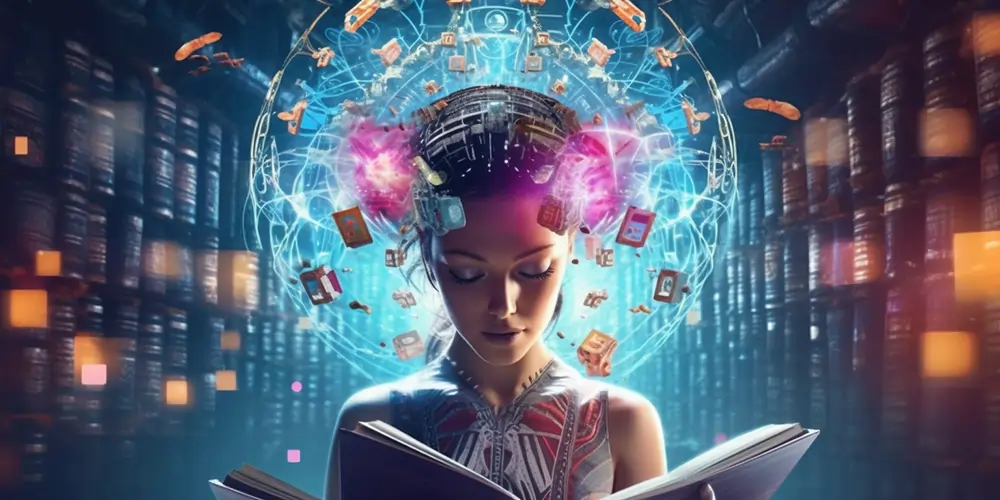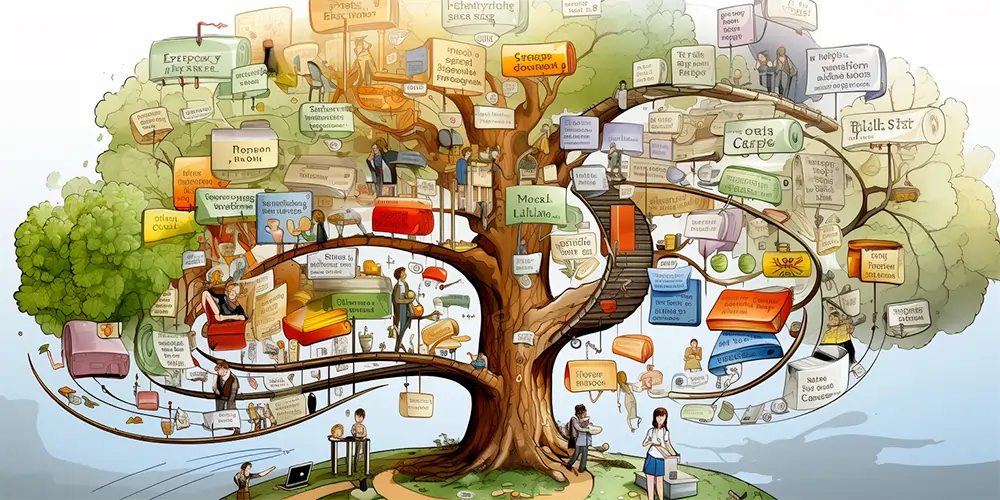Welcome to a world of AI-assisted education!
We will take you on a thoughtful journey to explore some creative and inventive ideas for the future of education, enriched by artificial intelligence and advanced technology.
We hope to educate and motivate you as we talk about ideas that could revolutionise the way we learn.
From customised learning journeys to holographic classrooms, we’ll touch on a variety of innovative possibilities that could impact the future of education. Let’s go!
Tailoring Education through AI Personalisation
Customised learning refers to tailoring educational experiences to meet each student’s unique needs, preferences, and abilities.
By gathering and analysing data on students’ learning preferences, interests, and performance and using that data to develop individualised learning paths, AI has the potential to play a significant role in this strategy.
Advantages of Customised Learning
- Enhanced Learning Outcomes: By adapting to each student’s individual needs, AI customised learning can help maximise understanding and retention of knowledge, leading to improved academic performance.
- Motivation and Engagement: Personalised learning experiences can make education more exciting and relevant to students, increasing their motivation to learn and participate in the process.
- Early Identification of Struggles: AI could help identify and address learning difficulties early on, allowing for timely interventions and support to prevent students from falling behind.
The Flip Side
- Over-reliance on Technology: There’s a risk that students and educators become too dependent on AI customised learning, potentially undermining the importance of human interaction in education.
- Privacy Concerns: The collection and analysis of personal data required for customised learning raise privacy and security concerns, as sensitive student information could be vulnerable to misuse or breaches.
- Implementation Challenges: Integrating AI customised learning into existing educational systems might be complex and costly, with potential barriers including inadequate infrastructure, insufficient teacher training, and resistance to change.
Customised learning journeys would offer promising benefits, such as enhanced learning outcomes and increased student engagement.
However, it’s important to weigh these advantages against potential drawbacks, such as privacy concerns and implementation challenges, to ensure a balanced and responsible approach to incorporating AI customised learning in education.

Immersive Worlds with VR and AR in Education
In the quest for more engaging and effective learning experiences, educators and technologists are turning to immersive learning environments.
By providing extremely interactive and lifelike experiences, these environments, powered by virtual reality and augmented reality technologies, have the potential to revolutionise education.
In education, these tools can be used to create engaging learning experiences that transport students into various scenarios, from historical events to simulated workspaces.
Advantages and Disadvantages
Immersive learning experiences come with several advantages.
For one, they can be highly engaging, making learning more enjoyable and motivating for students. Moreover, AI can personalise these experiences for each student, adapting the content to their individual needs and learning styles.
Additionally, immersive learning environments can simulate real-world situations, better preparing students for their future careers.
On the other hand, there are also potential disadvantages to consider. The cost of VR and AR technology may be prohibitive for some schools, creating a barrier to access.
Furthermore, excessive reliance on immersive learning environments could result in a diminished focus on traditional learning methods and the development of essential interpersonal skills.
Personalising Immersive Learning
AI could play a key role in personalising immersive learning experiences for each student.
By analysing individual data and preferences, AI could adapt the content and pace of VR and AR experiences to meet each student’s unique needs, further enhancing the effectiveness of these learning tools.
Simulating Real-World Situations
The ability of immersive learning environments to simulate real-world scenarios is one of their most promising features.
These simulations can become incredibly lifelike with the aid of AI, giving students the opportunity to develop practical experience and skills that they can use immediately in their future careers.
This practical approach to learning not only enhances knowledge retention but would also foster a deeper understanding of various subjects.

AI-guided Humanoid Teachers
The idea of humanoid robot teachers might sound like science fiction. Still, with advancements in AI and robotics, these futuristic educators could soon become a reality.
As we explore the potential impact of robotic instructors on education, it’s important to consider both the advantages and disadvantages that may accompany their integration into the classroom.
Humanoid Robot Teachers
Humanoid robot teachers would be robots designed to resemble humans, equipped with AI capabilities that enable them to perform teaching tasks.
These robots would interact with students, deliver lessons, and even provide feedback while adapting to each student’s unique learning style.
Advantages and Disadvantages
There are several potential advantages to employing robotic instructors in the classroom.
For one, AI could tailor the robot’s teaching style to individual learning styles, ensuring that each student receives instruction that is best suited to their needs.
AI could enable robotic instructors to detect and respond to student emotions, providing emotional support and encouragement when needed.
There are also disadvantages to consider. The introduction of robotic instructors could lead to a reduction in human interaction between students and teachers, which could negatively impact the development of interpersonal skills.
Furthermore, the cost of implementing and maintaining such technology might be prohibitive for some schools and communities.
Tailoring Teaching Styles
One of the most significant benefits of robotic instructors would be their ability to adapt their teaching style to each student’s individual learning style.
With AI capabilities, these robots could analyse student data and preferences, allowing them to modify their approach and better meet the needs of each learner.
Emotional Support and Responsiveness
Robotic instructors, empowered by AI, could also detect and respond to student emotions, providing a level of emotional support that might be challenging for human teachers to consistently offer.
These AI-powered robots could help maintain student engagement and give a more positive learning environment by recognising and addressing feelings of frustration, confusion, or boredom.
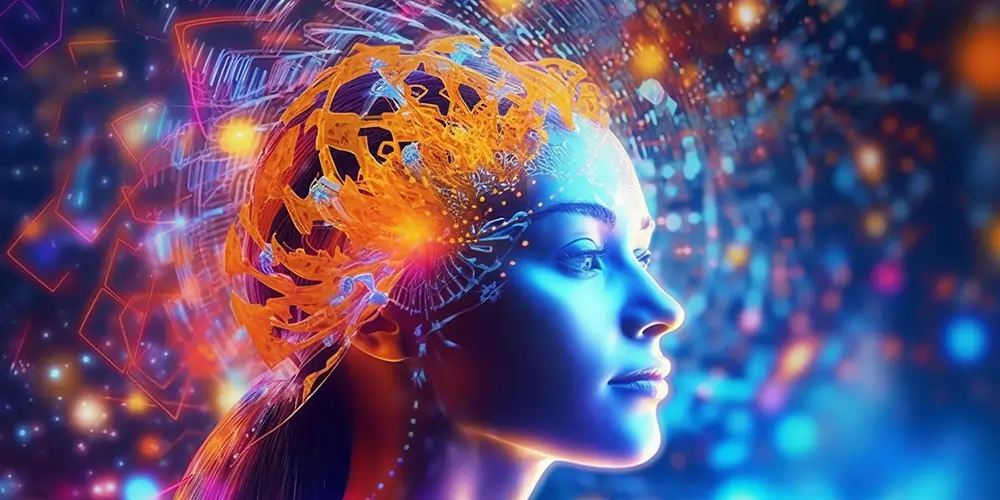
Brain-Powered Learning and AI Mind Control
Brain-powered learning, also known as mind-controlled learning, is an emerging concept that utilises brain-computer interfaces (BCIs) to facilitate direct communication between the human brain and learning material.
This innovative approach to teaching has the power to alter how we engage with and learn from knowledge.
Mind-Controlled Learning
Mind-controlled learning utilises brain-computer interfaces that allow users to interact with and manipulate educational content using only their thoughts.
By analysing brain signals, AI could personalise content based on students’ interests and engagement, leading to more effective learning experiences.
Advantages and Disadvantages
The potential advantages of brain-powered learning are numerous. AI could personalise content based on student interests and engagement, ensuring the material is relevant and captivating.
Additionally, AI could analyse brain signals to optimise individual learning experiences, enabling students to learn at their own pace and focus on areas where they need improvement.
There are potential disadvantages to consider. The implementation of brain-powered learning technology would raise privacy concerns, as personal data and brain activity would need to be closely monitored. Also, the cost and accessibility of BCIs might be prohibitive for some schools and communities.
Personalised Content for Student Engagement
AI would play a crucial role in personalising content for brain-powered learning.
By monitoring a student’s brain signals, AI could determine their interests and engagement levels and adapt educational content accordingly. This would ensure that students remain engaged and motivated throughout their learning experiences.
Optimising Learning through Brain Signal Analysis
The analysis of brain signals would also allow AI to optimise individual learning experiences. By detecting patterns in a student’s brain activity, AI could identify areas that need improvement or additional support, leading to more efficient and effective learning outcomes.
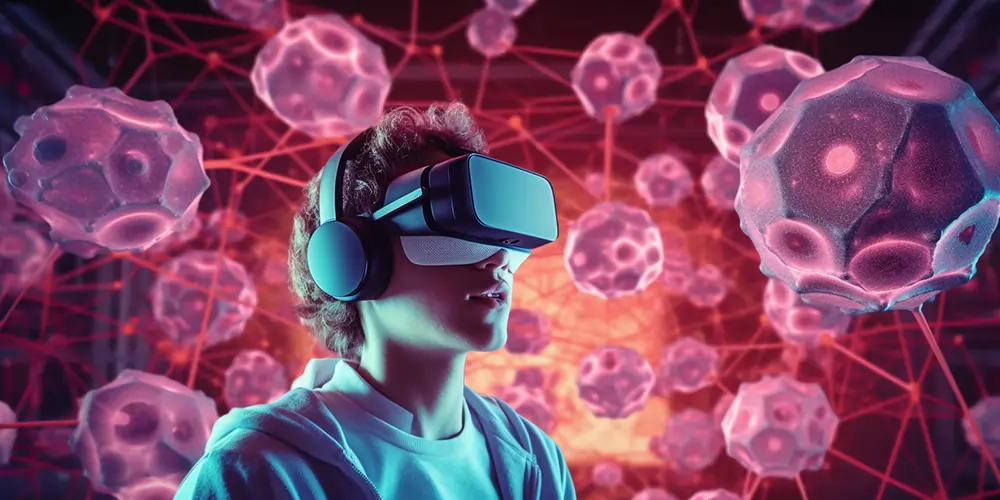
Holographic Learning in 3D Virtual Classrooms
Holographic classrooms, enabled by 3D virtual technology, have the potential to redefine the traditional classroom setting and facilitate global learning experiences.
Holographic Classrooms
Holographic classrooms are virtual learning environments that use 3D holography to create lifelike, immersive experiences.
Students can participate in these classrooms from anywhere in the world, allowing for a more diverse and interconnected learning experience.
Advantages and Disadvantages
Some potential advantages of holographic classrooms include:
- AI customisation: AI can customise the holographic classroom for each student, providing personalised learning experiences tailored to individual needs and preferences.
- Interactivity and collaboration: AI can increase interactivity and cooperation in the virtual classroom by facilitating real-time communication and group work among students, regardless of their physical location.
However, there are also potential disadvantages to consider:
- Technical challenges: Holographic classrooms may face technical challenges such as latency and connectivity issues, which could negatively impact the learning experience.
- Accessibility concerns: The cost of implementing and accessing holographic classrooms may be prohibitive for some schools and communities, potentially exacerbating educational inequality.
AI-Driven Customisation
By leveraging AI, holographic classrooms can be customised to suit the individual needs of each student.
This means that the virtual learning environment can adapt to a student’s preferred learning style, interests, and pace, making the learning experience more effective and enjoyable.
Interactivity and Collaboration
AI can also foster interactivity and collaboration within the holographic classroom by connecting students from all over the world.
This global learning environment encourages diverse perspectives, promotes cross-cultural understanding, and enables students to collaborate on projects and engage in real-time discussions, regardless of geographical barriers.
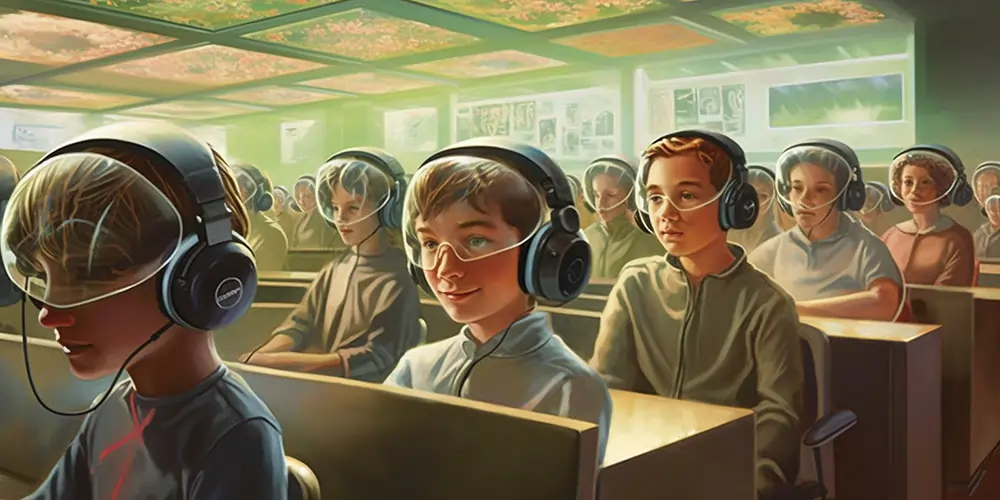
Empathetic AI Enhancing Emotional Well-being in Learning
Affective computing, another name for emotion-sensitive AI, is a new area of artificial intelligence that intends to recognise, analyse, and react to human emotions.
In the context of education, emotion-sensitive AI has the potential to significantly improve learning experiences by adapting to students’ emotional states.
Emotional AI in Education
Emotional AI can be integrated into educational platforms and tools to monitor and analyse students’ emotional states during learning.
By recognising and responding to these emotions, AI can offer support, resources, and tailored content to enhance engagement and motivation.
Advantages and Disadvantages
Potential advantages of emotion-sensitive AI in education include:
- Detecting and responding to mental health issues: AI can identify students experiencing mental health challenges, such as stress or anxiety, and provide appropriate support and resources to address their needs.
- Tailoring content to emotional states: AI can adapt educational content based on a student’s emotional state, ensuring that material remains engaging and motivating throughout the learning process.
However, there are potential disadvantages to consider:
- Privacy concerns: The use of emotion-sensitive AI raises privacy concerns, as sensitive personal information and emotional data would need to be collected and analysed.
- Misinterpretation of emotions: AI may not always accurately interpret emotions, which could lead to inappropriate responses or interventions.
Support for Mental Health Issues
Emotion-sensitive AI can play a critical role in detecting and responding to student mental health issues.
By recognising signs of stress, anxiety, or other emotional challenges, AI can provide targeted support, resources, and interventions to help students manage and overcome these obstacles.
Tailoring Content to Emotional States
AI’s ability to adapt educational content based on a student’s emotional state can greatly enhance engagement and motivation.
AI can ensure that the learning process remains captivating and relevant for each student by understanding and responding to emotions such as boredom, frustration, or enthusiasm.

Teleportation Classrooms Expanding Educational Horizons
Teleportation classrooms, while still a theoretical concept, imagine a future where students can instantly access learning opportunities from anywhere in the world.
By leveraging AI and advanced technologies, these teleportation classrooms could vastly expand educational opportunities and transform the way we learn.
Teleportation Classrooms
Teleportation classrooms envision a world where students can instantly “teleport” to any classroom or learning environment, regardless of their physical location.
This concept relies on the idea of advanced transportation technology and AI integration to provide personalised and accessible education for all.
Advantages and Disadvantages
Potential benefits of teleportation classrooms include:
- Personalised learning experiences: AI can personalise the teleportation classroom for each student, ensuring that the learning environment caters to individual needs, preferences, and learning styles.
- Worldwide learning experiences: AI can connect students with global teachers and experts, promoting diverse perspectives and a truly international educational experience.
However, there are potential disadvantages to consider:
- Technological limitations: The feasibility of teleportation technology remains uncertain, and its development may face significant challenges and constraints.
- Accessibility concerns: Similar to holographic classrooms, the cost of implementing and accessing teleportation classrooms may be prohibitive for some schools and communities, potentially exacerbating educational inequality.
AI Personalisation
In teleportation classrooms, AI can play a crucial role in personalising learning experiences for each student.
By understanding individual needs and preferences, AI can adapt the virtual classroom environment to best suit each student, enhancing their overall learning experience.
Connecting with Global Teachers and Experts
AI can facilitate connections between students and global teachers or experts in teleportation classrooms, allowing for a truly international educational experience.
This worldwide learning environment encourages diverse perspectives, promotes cross-cultural understanding, and broadens students’ horizons.
Balancing the Benefits and Challenges of AI-driven Education
As we’ve explored throughout this article, AI and advanced technologies offer numerous potential benefits and drawbacks in the context of education.
Potential Advantages and Disadvantages
Some potential advantages of AI and advanced technology in education include the following:
- Personalised learning experiences
- Immersive and engaging learning environments
- Expanded access to global teachers and resources
- Enhanced support for mental health and emotional well-being
Conversely, potential disadvantages include:
- Privacy concerns and ethical implications
- Technological limitations and accessibility concerns
- Misinterpretation of emotions or learning needs
- Potential negative impact on education jobs
Ethical and Practical Considerations
The ethical and practical concerns that come with AI in education must be addressed as we advance towards a time when it has a bigger impact on the sector.
AI’s impact on education jobs
The integration of AI and advanced technologies in education may lead to job displacement for educators, administrators, and support staff.
To mitigate these adverse effects, it is important to invest in reskilling and upskilling programs, as well as exploring new roles and opportunities for these professionals within the changing educational landscape.
AI’s potential to perpetuate or address inequalities
AI has the potential to either exacerbate or alleviate educational inequalities.
While personalised learning and expanded access to resources can help bridge the gap between disadvantaged and privileged students, the high costs and accessibility barriers associated with advanced technologies may disproportionately benefit wealthier communities.
Ensuring equal access to AI-driven educational tools and resources is essential to promoting equity and inclusivity in education.
Shaping the Future of Education with AI and Advanced Technology
We’ve explored the imaginative and outlandish possibilities for the future of education, enriched by AI and advanced technology.
We’ve discussed a range of concepts, including personalised learning journeys, immersive learning experiences, robotic instructors, brain-powered learning, 3D virtual classrooms, emotion-sensitive AI, and teleportation classrooms.
Each of these ideas presents potential advantages and disadvantages, as well as ethical and practical implications.
As we consider the future of education, it is crucial that we critically analyse the potential impact of AI and advanced technologies on learning experiences, educational equity, and the job market.
By striving towards this goal, we can envision a future where these groundbreaking innovations come together to provide more captivating, accessible, and inclusive learning experiences for everyone.
The path to the future of education is a thrilling adventure, filled with unknowns, obstacles, and potential breakthroughs.
As we forge ahead, let’s embody the spirit of creativity, introspection, and teamwork to build a future in which AI and advanced technologies empower and elevate the learning journeys of students everywhere.

